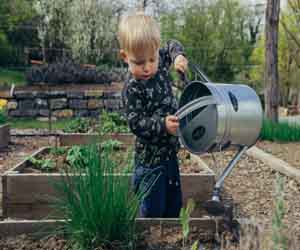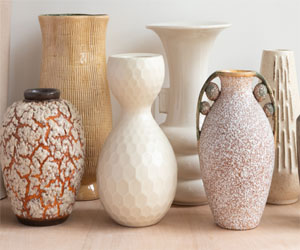

The Beauty Of Green Handmade Goods

In a world increasingly concerned about environmental sustainability, the appreciation for green handmade goods is on the rise. These unique creations embody the fusion of artistic expression and eco-consciousness, resulting in items that are not only aesthetically pleasing but also sustainable. In this article, we'll delve into the world of green handmade goods and explore their significance in our quest for a more environmentally friendly future.
Artistic Innovation Meets Sustainability
Green handmade goods are a testament to the union of creativity and environmental responsibility. Crafters and artisans across the globe are channeling their talents to produce items that not only serve a functional or decorative purpose but also adhere to eco-friendly principles. These goods are often made using natural or repurposed materials, creating a harmonious blend of artistry and sustainability.
Supporting Local Economies
One of the significant advantages of green handmade goods is their role in supporting local economies. Artisans and crafters, often small-scale businesses or individuals, contribute to their communities by crafting unique items. This helps strengthen local economies and reduces the carbon footprint associated with mass-produced, globally distributed products.
A Reduction In Waste
The process of creating green handmade goods encourages a reduction in waste. Many artisans rely on repurposed or upcycled materials, diverting items that might have otherwise ended up in landfills. The upcycling trend, in particular, is a testament to the innovative and sustainable approach taken by crafters.
Customization And Personalization
Green handmade goods offer a level of customization and personalization that is often lacking in mass-produced items. Artisans can tailor their creations to meet the unique needs and preferences of their customers. This not only reduces overconsumption but also fosters a deeper connection between the product and its owner.
Aesthetic Appeal And Uniqueness
Handmade goods, by their nature, are unique. They carry the mark of the artisan's personal style, reflecting their passion, creativity, and dedication. Each piece is a work of art, which enhances its aesthetic appeal. Green handmade goods often have an organic and rustic charm that resonates with those seeking natural beauty.
Reduced Environmental Impact
By choosing green handmade goods, consumers contribute to a reduced environmental impact. These goods typically involve fewer chemicals, lower energy consumption, and fewer emissions during production compared to mass manufacturing processes. Moreover, they often have longer lifespans, reducing the need for frequent replacements.
An Ethical Choice
When you purchase green handmade goods, you make an ethical choice. You support artisans who take pride in their work and ensure fair labor practices. This helps create a more equitable and socially responsible marketplace.
Green handmade goods are more than just aesthetically pleasing creations. They represent a conscious choice to support sustainable practices, local economies, and artisans. By opting for these unique and eco-friendly items, consumers play a vital role in crafting a more environmentally responsible and socially just future. Embracing green handmade goods isn't just about acquiring beautiful items; it's about making a statement for a greener, more sustainable world.
A Blooming Start To Your Green Journey
 Planning Your Garden
Planning Your Garden
A well-thought-out plan can make gardening more enjoyable and less overwhelming:
Design: Sketch your garden layout and decide where you want to place different plants. Consider factors like plant height, growth habits, and aesthetics.
Plant Selection: Choose plants that are suitable for your climate, soil type, and level of maintenance. Local garden centers can provide helpful recommendations.
Maintenance Schedule: Create a maintenance schedule that includes watering, fertilizing, and pruning. Regular tasks will help your garden flourish.
Essential Gardening Tools
Every gardener needs a basic set of tools:
Hand Trowel: For digging small holes and transplanting seedlings.
Pruning Shears: To trim and shape plants.
Gloves: To protect your hands from dirt and thorns.
Watering Can Or Hose: For proper irrigation.
Garden Rake And Hoe: For weeding and soil preparation.
Caring For Your Garden
The key to a thriving garden is care and attention:
Watering: Be mindful of your plant's water needs. Overwatering can be as harmful as underwatering. Learn to strike a balance.
Weeding: Regularly remove weeds, as they compete with your plants for nutrients and sunlight.
Fertilizing: Feed your plants with the appropriate fertilizers according to their needs. Some plants thrive with organic options, while others may benefit from slow-release synthetic fertilizers.
Pest Control: Keep an eye out for pests and diseases. Early detection and natural remedies can often prevent serious problems.
Pruning: Pruning helps maintain the shape of your plants, encourages new growth, and removes dead or diseased parts.
A Green Revolution In Beauty
 Clean Beauty: One of the core principles of plant-based cosmetics is their commitment to clean beauty. They avoid harmful chemicals, synthetic fragrances, and toxic additives found in traditional cosmetics. This reduces the risk of skin sensitivities, allergies, and long-term health issues.
Clean Beauty: One of the core principles of plant-based cosmetics is their commitment to clean beauty. They avoid harmful chemicals, synthetic fragrances, and toxic additives found in traditional cosmetics. This reduces the risk of skin sensitivities, allergies, and long-term health issues.
Sustainability In Practice: Many plant-based cosmetics brands prioritize sustainable practices. They responsibly source their ingredients, employ eco-friendly manufacturing methods, and package their products in recyclable or biodegradable materials. This substantially reduces their ecological footprint.
Cruelty-Free Commitment: A significant portion of plant-based cosmetics is cruelty-free, meaning they do not engage in animal testing. This aligns with the principles of compassionate consumerism and ethical treatment of animals.
Transparency And Accountability: Transparency is a hallmark of plant-based cosmetics brands. They provide clear and detailed information about their ingredients, sourcing, and production processes. This empowers consumers to make informed choices about the products they apply to their skin.
Broad Range Of Products: Plant-based cosmetics extend beyond skincare to include makeup products like foundations, lipsticks, and eyeshadows. These clean cosmetics provide safe and effective alternatives for enhancing beauty without compromise.
Holistic Beauty Philosophy: Plant-based cosmetics encourage a holistic approach to beauty, emphasizing the connection between external well-being and inner harmony. They advocate self-care, mental wellness, and self-confidence.
A Creative Path To Wellness
 Mindfulness: Crafting encourages mindfulness, which is the practice of being fully present in the moment. When you're immersed in a creative project, your focus shifts to the task at hand. This state of mindfulness can reduce symptoms of anxiety and depression and improve overall well-being.
Mindfulness: Crafting encourages mindfulness, which is the practice of being fully present in the moment. When you're immersed in a creative project, your focus shifts to the task at hand. This state of mindfulness can reduce symptoms of anxiety and depression and improve overall well-being.
Self-Esteem: Completing a craft project can provide a significant boost to self-esteem and self-worth. Seeing your creations come to life fosters a sense of accomplishment, pride, and a positive outlook on your abilities.
Distraction From Negative Thoughts: Crafting serves as a productive and enjoyable distraction from negative or intrusive thoughts. By focusing on the project, you can redirect your mental energy away from worries and concerns.
Social Connection: Crafting can be a social activity, allowing you to connect with others who share your interests. Joining crafting communities, attending workshops, or crafting with friends can provide a sense of belonging and reduce feelings of isolation.
Emotional Expression: Craft projects offer a creative outlet for emotional expression. Whether it's through painting, writing, or other crafts, you can channel your emotions and experiences into your creations, helping you process and cope with challenging feelings.
Neurological Benefits: Engaging in creative activities has been associated with changes in brain chemistry. These changes can lead to improved cognitive function, enhanced problem-solving skills, and a decrease in symptoms of mental health disorders.
Crafting Unique Brews In Your Kitchen
 Homebrewers often find inspiration in their surroundings and experiences. They may draw from their local environment, incorporating indigenous ingredients or regional flavors into their brews. For instance, someone living near a citrus orchard might use fresh oranges in their recipe, imparting a distinct regional character to the beer. Such a creative approach not only results in delicious brews but also connects the beer to a specific place, making it a unique and memorable experience.
Homebrewers often find inspiration in their surroundings and experiences. They may draw from their local environment, incorporating indigenous ingredients or regional flavors into their brews. For instance, someone living near a citrus orchard might use fresh oranges in their recipe, imparting a distinct regional character to the beer. Such a creative approach not only results in delicious brews but also connects the beer to a specific place, making it a unique and memorable experience.
Experimentation is another cornerstone of homebrewing creativity. Homebrewers are constantly tinkering with their recipes, trying new techniques, and pushing the boundaries of what's possible. This willingness to take risks leads to the discovery of innovative flavor combinations and brewing methods. Whether it's aging beer in oak barrels, using wild yeast strains, or adding unconventional ingredients like herbs and spices, the homebrewing world thrives on experimentation.
Furthermore, the craft beer movement has been instrumental in driving homebrewing creativity. As craft breweries continue to innovate and develop new styles, homebrewers often follow suit. They adapt commercial trends and make them their own, experimenting with hazy IPAs, sour ales, and barrel-aged wonders. The exchange of ideas between professional brewers and homebrewers has enriched both communities, resulting in a diverse spectrum of beer styles and flavors.
Community plays a crucial role in fostering creativity among homebrewers. Beer enthusiasts often gather in local homebrew clubs, online forums, and social media groups to share their experiences, knowledge, and creative ideas. This sense of community not only provides valuable feedback but also inspires brewers to explore new horizons. The camaraderie in the homebrewing world is palpable, and it's driven by a shared passion for experimentation and craft.
The Fusion Of Tradition And Innovation
 Ceramics, an art form with a history dating back millennia, has taken on new life in the contemporary art world. Contemporary ceramics represent a dynamic fusion of traditional techniques and innovative ideas, resulting in a breathtaking array of artistic expressions. This revitalized craft has garnered international attention and a dedicated following among artists and collectors.
Ceramics, an art form with a history dating back millennia, has taken on new life in the contemporary art world. Contemporary ceramics represent a dynamic fusion of traditional techniques and innovative ideas, resulting in a breathtaking array of artistic expressions. This revitalized craft has garnered international attention and a dedicated following among artists and collectors.
Breaking Boundaries: Contemporary ceramics are marked by a fearless embrace of experimentation. Artists working in this medium are unafraid to push the boundaries of traditional ceramics, often combining clay with other materials such as metals, glass, or textiles. The use of digital technology has enabled artists to design intricate patterns and precise shapes, opening up entirely new possibilities.
Diverse Styles And Themes: One of the most exciting aspects of contemporary ceramics is the diversity of styles and themes explored by artists. From minimalist and functional pottery to abstract and conceptual sculptures, contemporary ceramics encompass a wide range of artistic expressions.
A Journey Of Craftsmanship And Creativity
 3. Wood Selection: Choosing the right wood is a fundamental step. Different woods have varying characteristics, such as hardness, grain pattern, and color. As a beginner, it's wise to begin with softwoods like pine or cedar due to their ease of workability. Once you gain experience, you can move on to hardwoods like oak, maple, and cherry.
3. Wood Selection: Choosing the right wood is a fundamental step. Different woods have varying characteristics, such as hardness, grain pattern, and color. As a beginner, it's wise to begin with softwoods like pine or cedar due to their ease of workability. Once you gain experience, you can move on to hardwoods like oak, maple, and cherry.
4. Measuring And Marking: Accurate measurements and precise markings are the backbone of woodworking. Learn to use measuring tools, such as tape measures, squares, and calipers. Understand the significance of measuring twice and cutting once, as even minor measurement errors can affect the outcome of your project.
5. Wood Joinery: Wood joinery refers to the methods used to connect pieces of wood together. Basic joint types like butt joints, lap joints, and dowel joints are a good place to start. As you advance, explore more complex joints such as mortise and tenon, dovetail, and finger joints. Proper joinery is essential for strong, stable, and aesthetically pleasing woodworking projects.
6. Finishing Techniques: The finishing touches can make or break a woodworking project. Learn about the various finishing techniques, including sanding, staining, and applying protective coatings like varnish or polyurethane. Proper finishing not only enhances the appearance of your work but also protects it from the elements and wear and tear.
7. Woodworking Plans: For beginners, it's often helpful to work from pre-designed woodworking plans. These plans provide step-by-step instructions, detailed drawings, and a list of necessary materials and tools. Working with plans can help you understand the construction process and build your confidence in the craft.
Unlocking Beauty With Natural Ingredients
 Healing With Herbs: Herbs have been used for centuries in traditional medicine and beauty practices. Ingredients like chamomile, calendula, and lavender possess anti-inflammatory and healing properties, making them ideal for calming irritated skin and promoting an even complexion.
Healing With Herbs: Herbs have been used for centuries in traditional medicine and beauty practices. Ingredients like chamomile, calendula, and lavender possess anti-inflammatory and healing properties, making them ideal for calming irritated skin and promoting an even complexion.
The Miracle Of Essential Oils: Essential oils are concentrated extracts from plants and are known for their therapeutic properties. Lavender, tea tree, and rosehip oils are excellent choices for skincare, offering benefits such as acne reduction, scar healing, and anti-aging effects.
Fruit Extracts: Fruits like papaya, pineapple, and citrus fruits contain natural enzymes and acids that gently exfoliate the skin, leaving it brighter and more radiant. They are commonly found in natural peels and masks.
The Green Beauty Revolution: The natural beauty movement has given rise to the concept of "green beauty." Green beauty emphasizes the use of clean, natural, and eco-friendly ingredients. Many beauty companies are now formulating products without harmful chemicals, ensuring they are safe for both individuals and the environment.
DIY Beauty: For those who prefer a hands-on approach, DIY beauty using natural ingredients is becoming increasingly popular. Homemade masks, scrubs, and serums can be easily prepared with ingredients from your kitchen or garden, allowing you to tailor them to your specific skincare needs.
Holistic Approach: Natural beauty ingredients are not just about external application; they can also be part of a holistic approach to health and well-being. A balanced diet rich in fruits and vegetables can improve skin and hair health from the inside out.